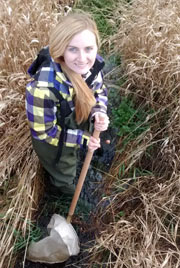Volunteering abroad for nature
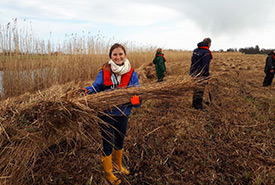
Clearing reed bed vegetation (Photo courtesy of Megan Quinn/NCC staff)
I don’t vacation very well. The problem with loving my job as a conservation biologist is that I have a hard time taking a holiday (and even when I do, I usually keep an eye on my work email inbox). So when I had the volunteer opportunity to spend a month travelling to England and the Netherlands, I wasn’t thinking about royals, clogs and windmills — my mind was on nature.
My first stop in England brought me back to the beautiful Peak District. I was lucky enough to first work in this area four years ago when I conducted a survey on European water voles at the Lathkill Dale Nature Reserve. Characterized by the steep limestone valleys of the White Peak and the impressive gritstone ridges of the Dark Peak, the area offers a breathtaking backdrop for field work.
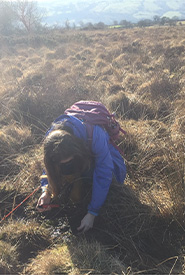
Poking the peatland with a stick (Photo courtesy of Megan Quinn/NCC staff)
This time, I volunteered to join fellow colleague and friend Ros Tratt to map the hydrology of the Swallow Moss Complex. There, we recorded information about ditches, drains, pools, springs and seepages to get a better understanding of how water was flowing in the moorland. I probably undersold the job by telling my friends back home that I spent the day poking a stick in the ground to measure peat depth. Coming from the frozen Canadian winter, it was great to get my boots muddy again.
I was worried that I would be trying to overcome a big knowledge gap, since all of my training and education has been focused on ecosystems in Ontario. However, the protocols and equipment in England were all very similar, just on the other side of the ocean. Ros and I even ended our day with ice cream, which is something the crew back in Canada has been known to do (although not in February).
Related blog posts
After England, I travelled to the Netherlands. If I was worried about trying to keep up with environmental work in England, I now had a foreign language to deal with. I contacted Landschap Noord Holland, a conservation organization that works in the province of North Holland, and arranged some volunteering.
I love all ecosystems, but if I had to pick a favourite, it would be wetlands. Considering the country is mostly below sea level, the Netherlands has a lot of them. My guide and I spent a few days in north Holland. We first visited Eilandspolder nature reserve, where a volunteer event was taking place. I travelled with the team by boat to reed beds, where the task for the day was to remove dense vegetation to improve breeding bird habitat.
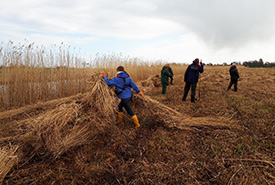
Clearing reed bed vegetation (Photo courtesy of Megan Quinn/NCC staff)
After an evening of touring even more nature areas, day two took us to Fort Krommeniedijk, where the flooded fields provide excellent breeding bird habitat. That afternoon, I met a group of volunteers at Ilperveld and toured the property by boat (other than bicycles, this seems to be the way to get around here). Despite the wind, we visited and learned about a floating reed mat, an ecosystem where large mats of reed grass that are stable enough to walk on float on the surface of the water. I was surprised by how many species I was able to identify, simply because of how closely they resembled the ones we have in Canada.
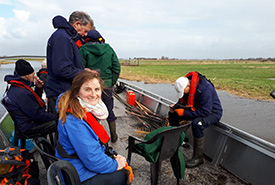
The view from the boat in the Netherlands is not too different from Canada. (Photo courtesy of Megan Quinn/NCC staff)
Environmental work in the Netherlands is different than in eastern Ontario. For one thing, the challenge of population density and human pressure is magnified in the Netherlands. The Township of Rideau Lakes, where my office is, has a population density of 14.2 people per square kilometre. To put that into perspective, the population density of the Netherlands is 488 people per square kilometre, making it one of the most densely populated countries in the world. I was expecting there to be very little nature and was surprised by how significant the remaining bits were.
I spent three days on the island of Terschelling, one of the five Dutch islands in the Wadden Sea. The Wadden Islands have international ecological importance as a migratory stopover and wintering site for birds. Every year, hundreds of thousands of birds descend onto the mud flats and coastal dunes to refuel and breed. Like the Frontenac Arch in eastern Ontario, the Wadden Sea Area is a UNESCO Biosphere Reserve, and the majority of Terschelling is protected as a nature reserve. I was lucky enough to be able to explore the trails just before they closed for the bird-nesting season.
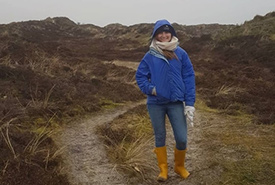
Me on the Island of Terschelling (Photo courtesy of Megan Quinn/NCC staff)
There are obviously still challenges and improvements that can be made to the Dutch system, but seeing how conservationists innovate to advocate for nature in their country is inspiring. It also reminds me of how lucky I am to live somewhere where nature is relatively intact.
Travelling expands your worldview, and I think it’s especially important for those working in the field of conservation. We might speak different languages, have different accents and call things by different names, but we are all working toward the same goal: trying to protect the planet and its ecosystems.
Unfortunately, so often we work in isolation. Building international relations with my fellow conservationists inspires me to keep working. Volunteering on my holiday gave me the chance to share knowledge about the issues I face in my job and gain a better understanding of how conservation work is performed in Europe. Although I returned to a daunting number of emails in my work inbox, it was definitely worth it.
I’ve already started planning my next trip in October, and you can bet I will spend a lot of my time outside.

